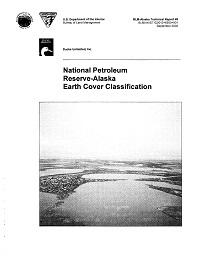National Petroleum Reserve-Alaska Earth Cover Classification

The National Petroleum Reserve in Alaska (NPR-A) includes more than 9.3 million hectares (23.0 million acres) and is located on the North Slope of Alaska. The northern half of the NPRA falls within the Arctic Coastal Plain physiographic province which contains one of the largest and most stable collections of wetlands in North America. Currently, with the potential for oil development extending into areas, other than Prudhoe Bay, an Environmental Impact Statement (EIS) is being prepared for the Northeastern Planning Area of the NPR-A.
The objective of this project was to create an updated and detailed earth cover inventory in computer database format for the entire NPR-A. The purpose of the project was to develop a tool for aiding in the management of the NPR-A and for developing baseline information that could be used in other studies. This inventory is currently included in the Environmental Impact Statement for the Northeastern Planning Area of the NPR-A. It is also included in the waterfowl earth cover selection analysis that created selection indexes based on earth cover types for seven different waterfowl species.
Landsat Thematic Mapper (TM) satellite imagery was chosen as the primary source for this mapping because it is a cost effective data source for regional mapping, can be processed using automated mapping techniques, and is collected on a repeat cycle, providing a standardized data source for future database updates. In addition, TM imagery includes a mid-infrared band, which is sensitive to both vegetation and soil moisture content and has proven useful in identifying water and wetland features. Eight Landsat TM satellite scenes and three Systeme Pour !'Observation de la Terre (SPOT) satellite scenes were used to classify the NPR-A into earth cover categories. An unsupervised clustering or seeding technique was used to determine the location of field sites and a custom field data collection card was used to record field information. After initial on-the-ground sampling, a helicopter was used to access field sites throughout the project area. Global positioning system (GPS) technology was used to navigate to preselected sites and record locations of new selected sites. Data were collected on 1,667 field sites during a three year field season from 1994 through 1996. A portion (46%) of these field sites were set aside for accuracy assessment.
A combined supervised/unsupervised classification technique was performed to classify the satellite imagery into seven major classes and seventeen minor classes. As each scene was completed it was mosaicked and edge matched with adjacent scenes to produce a seamless database of the NPR-A.
The results of this classification suggest dominant earth cover of the NPR-A at 43% shrub, 31% moist tundra, 11% water, 6% flooded tundra, 5% wet tundra, 2% aquatic, and 2% barren ground. The overall accuracy of the major categories was 85%, with a 75% overall accuracy for the minor categories. The cooperators in this project included Bureau of Land Management-Alaska; Ducks Unlimited, Inc.; U.S. Fish and Wildlife Service; and North Slope Borough.
